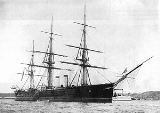
Russian cruiser Gerzog Edinburgski
Encyclopedia
The Gerzog Edinburgski (Герцог Эдинбургский) was an armoured cruiser built for the Imperial Russian Navy
. She was a sister ship of the Russian cruiser General-Admiral (1873)
and was named after Alfred, Duke of Saxe-Coburg and Gotha
, Duke of Edinburgh ( Gerzog Edinburgski in Russian) who married Grand Duchess Maria Alexandrovna of Russia.
The ship was originally to be named Alexander Nevski but renamed before launch. She was launched in 1875 and Served at Far East
1879–1884 and at Mediterranean Sea
1897–c.1900, used as training vessel since early 1900s. She was converted to a second line minelayer in 1908. The ship could carry 600 mines and was renamed Onega. She was hulked in 1915 as a depot ship and renamed № 4, Barrikada \ «Баррикада», № 9) after the revolution. She was broken up in 1949.
Imperial Russian Navy
The Imperial Russian Navy refers to the Tsarist fleets prior to the February Revolution.-First Romanovs:Under Tsar Mikhail Feodorovich, construction of the first three-masted ship, actually built within Russia, was completed in 1636. It was built in Balakhna by Danish shipbuilders from Holstein...
. She was a sister ship of the Russian cruiser General-Admiral (1873)
Russian cruiser General-Admiral (1873)
General-Admiral was the lead ship of the armored cruisers built for the Imperial Russian Navy in the early 1870s. She is generally considered as the first true armored cruiser.-Design and description:...
and was named after Alfred, Duke of Saxe-Coburg and Gotha
Alfred, Duke of Saxe-Coburg and Gotha
Alfred, Duke of Saxe-Coburg and Gotha was the third Duke of Saxe-Coburg and Gotha, and reigned from 1893 to 1900. He was also a member of the British Royal Family, the second son and fourth child of Queen Victoria and Prince Albert of Saxe-Coburg and Gotha...
, Duke of Edinburgh ( Gerzog Edinburgski in Russian) who married Grand Duchess Maria Alexandrovna of Russia.
The ship was originally to be named Alexander Nevski but renamed before launch. She was launched in 1875 and Served at Far East
Far East
The Far East is an English term mostly describing East Asia and Southeast Asia, with South Asia sometimes also included for economic and cultural reasons.The term came into use in European geopolitical discourse in the 19th century,...
1879–1884 and at Mediterranean Sea
Mediterranean Sea
The Mediterranean Sea is a sea connected to the Atlantic Ocean surrounded by the Mediterranean region and almost completely enclosed by land: on the north by Anatolia and Europe, on the south by North Africa, and on the east by the Levant...
1897–c.1900, used as training vessel since early 1900s. She was converted to a second line minelayer in 1908. The ship could carry 600 mines and was renamed Onega. She was hulked in 1915 as a depot ship and renamed № 4, Barrikada \ «Баррикада», № 9) after the revolution. She was broken up in 1949.

